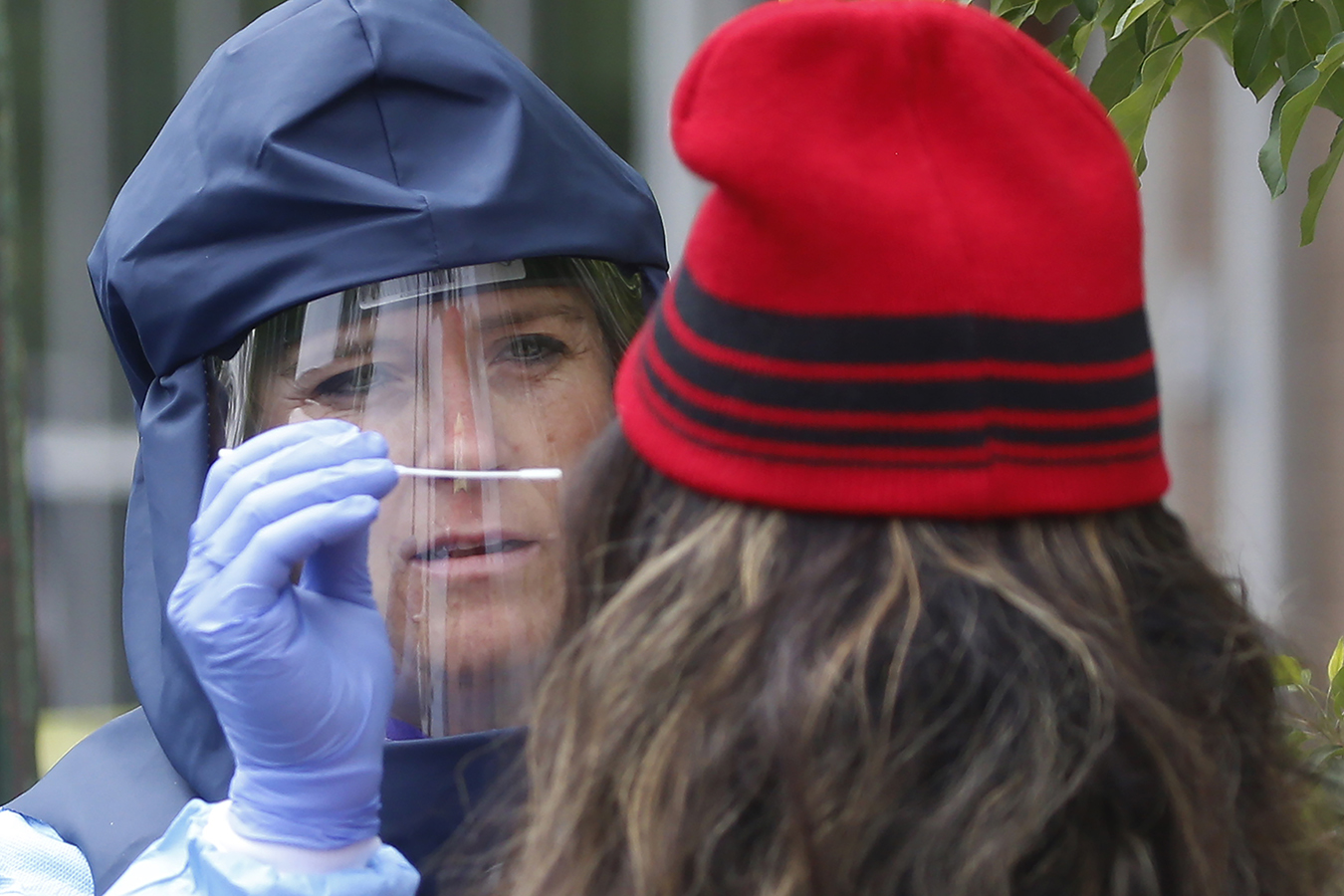ST. LOUIS — Missourians have driven hours to find vaccines in rural counties — at least those with cars and the time. Tens of thousands of doses are waiting to be distributed, slowly being rolled out in a federal long-term care program. Waitlists are hundreds of thousands of people long. Black residents are getting left behind.
Missouri’s rocky vaccine rollout places it among the bottom states nationwide, with 23.7% of the population vaccinated with at least one dose as of Thursday, compared with the national average of 26.3%. If Missouri were on par with the national rate, that would be roughly equivalent to more than 162,000 additional people vaccinated, or almost the entire population of the city of Springfield.
Part of the problem, health experts said, is that the state bypassed its 115 local health departments in its initial vaccine rollout plans. Instead, state officials largely outsourced the work to hospitals, consultants and federal programs, reasoning hospitals and mass vaccination sites had the workforce and facilities to deliver high numbers of vaccines.
Meanwhile, local health departments and federally qualified health centers, which typically reach the most vulnerable populations not connected to traditional health systems, were each initially left to divvy up about 8% of the state’s vaccine supply. That allocation has since increased to 15%, but it hasn’t been enough to fill the remaining gaps.
“You get what we pay for,” said Spring Schmidt, former co-acting director of the St. Louis County health department, noting public health departments in the state have been underfunded for decades. “This is an infrastructure that is similar to governmental utilities or other services that our citizens expect to be provided for them and tend to only notice when they fall.”
The local health departments knew what needed to be done. “We’ve drilled for this, we’ve got plans on shelves that are collecting dust for this,” Schmidt said.
But that’s the rub of long-standing health department underfunding: Even with all the plans honed in flu and H1N1 vaccination campaigns, health departments still would need the staff and facilities to pull off something of this scale, said Dr. Alex Garza, head of the St. Louis Metropolitan Pandemic Task Force, a consortium of the area’s major hospital systems. And the state and county governments aren’t providing the necessary funding to do the job.
A 2020 Kaiser Health News and AP investigation found that Missouri public health staffing at the state level had fallen 8% from 2010 to 2019, a loss of 106 full-time employees. Public health spending per Missourian was $50 per year — one of the bottom 10 states in the nation.
When the pandemic struck, local health departments had only 408 employees trained to give vaccinations, according to a report released Friday by #HealthierMO, a group advocating for better public health in the state. That means if only those staffers had given vaccines, they would each need to vaccinate some 15,000 people — in many cases, administering two shots. In even the most efficient scenario, with each person taking five minutes to vaccinate, that would take more than seven months for just one shot per person.
Hollowed-Out Public Health System Faces More Cuts Amid Virus
The U.S. public health system has been starved for decades and lacks the resources necessary to confront the worst health crisis in a century.
Read MoreAt the same time, public health officials get blamed for enacting pandemic safety measures. State legislators are discussing limits to public health powers and local officials have withheld funding from their health departments, hindering their power to act in the crisis.
A Question of Equity
Missouri public health officials said the outsourcing approach missed the mark on the mission of public health: getting the vaccine to those who need it the most.
Only 9.9% of Black Missourians are vaccinated, as opposed to 18.3% of white Missourians, according to available data. A series of reports produced by Deloitte, a major consulting firm advising the state on the rollout, showed a pattern of vaccine deserts in metro areas, where the state’s Black residents are concentrated.
Nationally, non-Hispanic Black Americans are 1.9 times more likely to die of covid than white Americans, according to a Centers for Disease Control and Prevention analysis. Black Missourians make up 13.1% of the state’s covid deaths, higher than their 11.8% share of the population.
Some of the Deloitte reports in early March also found nearly a third of Missouri residents traveled outside their county to get vaccinated. Democratic state Sen. Jill Schupp and other critics have said the initial rollout data shows it’s because the geographic allocation of vaccines did not match up with population sizes.
“If you are elderly and don’t do that kind of driving, if you’re low-income and don’t have that access to transportation, if you’re a working person who can’t take time off work to drive an hour and a half one way to get your vaccine — those people are left to fend for themselves,” Schupp said.
Decisions were made to prioritize vaccines based on population and risk factors, said state Health and Senior Services Director Dr. Randall Williams and Gov. Mike Parson’s deputy chief of staff, Robert Knodell. They say no single group would be happy with their allocation amid the limited initial vaccine supply.
Adam Crumbliss, the state’s director for its division of community and public health, noted state officials have concerns about data discrepancies that have made Missouri appear to be lagging. Missouri state health officials and federal government officials have sparred over at least four data issues.
CDC spokesperson Kate Fowlie said a state file recording over 34,000 administered doses did not upload to federal systems due to data errors in January, and the state took two weeks to fix it. She added the CDC and Missouri have had an ongoing conversation about missing data from a provider who had improperly submitted counts of doses given.
Crumbliss also said some 76,000 unused doses are in the long-term care facilities pharmacy program with CVS and Walgreens, which slows down Missouri’s vaccination rate. The federal initiative has come under fire for its delays.
But according to the CDC, only 50,000 or so doses in the pharmacy program are left to be administered in Missouri. “A handful of long-term care facilities in Missouri had a late start on their first clinics, and are therefore still wrapping up the third and final clinics,” Fowlie said, noting the state could work with the federal partnership to redistribute any remaining doses.
A Political Matter
At the very heart of the heartland, Missouri is one of the states that never enacted a mask mandate — not even after the Republican governor and his wife contracted covid-19 in September.
Parson also hasn’t shied away from fights with health officials. After Garza called for more vaccine doses to be allocated to the St. Louis area in early February, Parson accused him of spreading “fear and panic” with false information.
But after weeks of outcry, the state began to target the more populated St. Louis and Kansas City areas. Parson has also begun tweeting in support of local public health officials.
Still, the political animus against public health is continuing in the Missouri legislature — as it is in at least 23 other states — where lawmakers are weighing bills to curtail public health powers. The deployment of quarantine orders and other long-standing public health powers to combat the pandemic are now up for debate, while public health departments fight for funding.
“No one is wearing masks in the Capitol, and you’re asking public health officials to go and testify in person, against their own guidance,” said Will Marrs, a lobbyist for the Missouri Association of Local Health Agencies. “It’s very much not normal.”
Legislators did not fight, however, over an emergency ruling for businesses and organizations to officially jump the vaccination line. So far, at least 90 have applied. Records obtained by KHN show that the state health department approved at least 15 entities to get the vaccines earlier, including health care giant Centene and the St. Louis Convention and Visitors Commission, as well as libraries and companies assisting in covid testing and vaccine manufacturing.
The Funding Question
Even amid a pandemic, it’s been a struggle to get money to local health departments. The state used $9.8 million initially sent from the CDC last spring, instead of passing it along to local health departments.
Last summer, state legislators decided that county commissioners would determine whether local health departments got CARES Act funding. Many commissioners were mad at their health departments for shutting down local businesses, so they refused to fork over funds, said Larry Jones, executive director for the Missouri Center for Public Health Excellence, a consortium of public health leaders.
According to a state health department survey, at least 40 local health departments hadn’t received any of the money as of early October. Those that did reported an average of 8% of county CARES money, instead of the state-recommended 15%.
In Kansas City, over $226,000 in CARES funds was allocated over the summer to Cruise Holidays, a travel company, according to Platte County’s Landmark newspaper. It wasn’t until this March that the local health department received almost $228,000, said department spokesperson Natalie Klaus, far less than the $1.8 million the state recommended.
The state has been allocated $55 million from the CDC for the vaccine rollout, of which state health department spokesperson Lisa Cox said $20 million is heading to local departments soon. More is expected to come in the new $1.9 trillion federal stimulus package.
Jones is concerned history will repeat itself with vaccination funding not getting where it helps the most people. Brian Castrucci, CEO of the de Beaumont Foundation, which advocates for public health, also isn’t optimistic.
“How confident are we that states that are actively trying to limit public health authority are going to do a good job of spending this money appropriately?”
KHN data reporter Hannah Recht contributed to this report.









